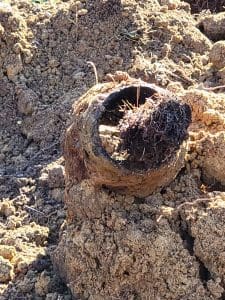 Okay, so you have sewer line backup… Did you know that in many areas, homeowners are responsible for maintaining and repairing the sewer lines, including plumbing repairs, that run from their homes to the main sewer system? This often surprises many, as the common assumption is that the city or municipality takes care of these underground systems. However, when issues arise with sewer lines, it’s crucial to understand who is responsible for addressing them. If you have questions, please give us a call!
Okay, so you have sewer line backup… Did you know that in many areas, homeowners are responsible for maintaining and repairing the sewer lines, including plumbing repairs, that run from their homes to the main sewer system? This often surprises many, as the common assumption is that the city or municipality takes care of these underground systems. However, when issues arise with sewer lines, it’s crucial to understand who is responsible for addressing them. If you have questions, please give us a call!
Sewer Line Basics
Transport Function
Sewer lines play a crucial role in transporting wastewater from homes to the public main for treatment. They ensure proper sanitation.
Components Overview
A typical sewer line system consists of laterals and mains. Laterals connect individual properties to the main sewer line, while mains carry wastewater to treatment facilities.
Importance of Maintenance
Proper maintenance is essential to prevent sewer line issues such as clogs, leaks, and breaks. Regular inspections and repairs can help avoid costly replacements.
City Responsibility and Sewer Lines
Property Owners
Property owners are typically responsible for maintaining and repairing the sewer lines from their properties to the main sewer line. This includes addressing clogs, breakages, or general wear and tear in underground sewer pipes.
Location Variations
The responsibility for sewer line repairs can vary by location. Property owners bear the full responsibility in some areas, while in others, the city or municipality may take on a portion of the repair costs.
Contacting the Municipal Sewer Department
Property owners can contact the city or municipal sewer department to clarify who is responsible for sewer line repairs. These departments can provide information on repair responsibilities, permit requirements, and regulations related to sewer infrastructure maintenance.
Understanding Sewer Laterals
Upper vs. Lower
Sewer laterals, also known as lateral sewer lines, consist of the upper and lower laterals. The upper lateral runs from a property to the main city sewer line, while the lower lateral connects the house to the upper lateral.
The responsibility for repairing these lines is typically split between homeowners and municipalities. Homeowners are usually accountable for the lateral line sewer break in the lower lateral on their property. On the other hand, municipalities are responsible for issues that arise in the upper lateral or beyond, towards the main sewer line.
Connection to Main Line
The lateral pipe runs from a building’s plumbing system to the municipal sewer system. It is a crucial link between a property and the city’s infrastructure, including the municipal sewer system. Any damage or blockage in this lateral pipe can lead to backups and sewage issues within the property.
Municipalities step in to handle repairs in case of problems with the upper lateral or main sewer line. However, when it comes to laterals on private property, homeowners bear the financial burden of maintaining and fixing these connections.
Causes and Prevention of Sewer Backups
Grease Buildup
Grease accumulation in sewer lines is a common cause of backups. When grease is poured down drains, it solidifies over time, leading to blockages.
To prevent this, avoid pouring grease down the drain and dispose of it in a sealed container.
 Root Intrusion
Root Intrusion
Tree roots seeking moisture can infiltrate sewer pipes, causing main blockages. Regular maintenance and root removal can prevent this issue.
Consider scheduling regular inspections to detect root intrusion early and take necessary actions to prevent further damage.
Importance of Maintenance
Regular inspections and maintenance are crucial in preventing backups. Preventive measures like installing a sewer backflow valve can help avoid costly repairs.
Trenchless Repair Techniques
Structural Pipe Lining
Structural pipe lining is a trenchless repair method that involves inserting an epoxy-saturated liner into the damaged sewer line. This liner hardens to form a new pipe within the existing one, effectively sealing off cracks and preventing leaks.
Pipe Bursting
Pipe bursting is another innovative trenchless repair technique where a new pipe is pulled through the damaged one, breaking apart the old pipe. This method is particularly effective in replacing old, deteriorated pipes without requiring extensive digging.
Benefits of Trenchless Repair
- Minimally Invasive: Unlike traditional excavation methods that require digging up the entire sewer line, trenchless repairs are minimally invasive, causing less disruption to landscaping and property.
- Cost-Effective Solutions: Trenchless repair techniques can be more cost-effective in the long run, as they eliminate the need for extensive digging and restoration work.
Advantages Over Traditional Methods
- Time-Saving: Trenchless repairs are often quicker to complete than traditional methods, reducing downtime and inconvenience for homeowners.
- Durability: The new pipes installed using trenchless techniques are highly durable and resistant to common issues like tree root intrusion.
Summary
Understanding the responsibilities related to sewer lines is crucial for homeowners. Knowing who is accountable for what can save you time, money, and stress. From the basics of sewer lines to the causes of backups and repair techniques, you now have a comprehensive overview to navigate any sewer-related issues effectively. Remember, prevention is critical, so regular maintenance and awareness of your city’s policies can help you avoid costly problems in the future.
Take charge of your sewer line knowledge and be proactive in its maintenance. Stay informed about your city’s regulations and invest in preventative measures to keep your sewer system running smoothly. By staying educated and prepared, you can ensure that your sewer lines remain in top condition, saving you from unexpected headaches down the line.

Frequently Asked Questions
Who is responsible for maintaining sewer lines?
The responsibility for maintaining sewer lines typically falls on the property owner. Homeowners are usually responsible for the sewer line running from their house to the connection with the city’s main sewer line.
Can the city be held responsible for sewer line issues on my property?
In most cases, the city is responsible for maintaining and repairing the main sewer line that runs along public streets. However, any issues arising from the sewer lateral connecting your property to the main line are usually the homeowner’s responsibility.
What are the common causes of sewer backups?
Common causes of sewer backups include tree roots infiltrating pipes, grease buildup, flushing non-biodegradable items, structural defects in pipes, and heavy rainfall overwhelming the system. Regular maintenance and proper disposal practices can help prevent these issues.
How can sewer backups be prevented?
To prevent sewer backups, avoid flushing non-biodegradable items, dispose of grease properly, schedule regular inspections and maintenance, install backwater valves, and consider trenchless repair techniques to address any existing issues proactively.
What are trenchless repair techniques for sewer lines?
Trenchless repair techniques involve fixing sewer line issues without extensive digging. Methods like pipe lining and pipe bursting allow for repairs to be made underground without disrupting landscapes or structures above. These techniques are efficient, cost-effective, and minimize environmental impact.

 Root Intrusion
Root Intrusion
0 Comments